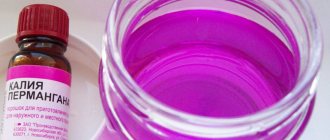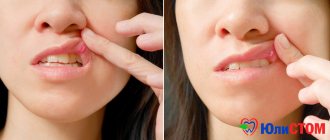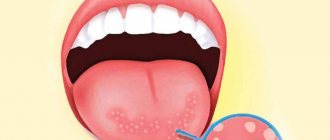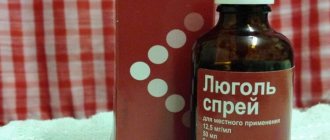Stomatitis during pregnancy is a fairly common pathology. At this time, the immune system becomes weaker and the body directs all its strength to the development and growth of the fetus. The expectant mother's immunity drops, which can trigger the development of various diseases. In addition, the development of stomatitis can be influenced by hormonal changes in the body.
Stomatitis is manifested by inflammatory ulcers, which are usually localized on the oral mucosa. Ulcers cause significant discomfort to the expectant mother and prevent her from eating normally.
If stomatitis starts, it can lead to serious consequences.
Only a specialist can prescribe the correct treatment; you should not prescribe medications yourself.
Most often, stomatitis appears in the early stages of pregnancy, at a time when the female body is undergoing restructuring.
There are several types of disease:
- Fungal or candida species. As a rule, it occurs due to reduced immunity. It is characterized by itching, pain, and the tongue is covered with a white coating.
- Viral type. This type can be contracted from an already sick person who is a carrier of the disease. Most often, the disease manifests itself in the winter-spring season, when many are susceptible to vitamin deficiency.
- Allergic type. If the expectant mother is susceptible to allergies, she may develop this type of pathology.
A dentist will be able to make the correct diagnosis and determine the type of pathology.
Pimples in the mouth and discomfort while eating are the main symptoms of the development of the disease.
Other symptoms are:
- redness of the tongue and palate;
- the appearance of plaque;
- burning and itching, especially when eating;
- increased body temperature;
- increased salivation.
Most often, the disease is diagnosed in the fifth or sixth week of pregnancy. Often, the disease can manifest itself again in the third trimester, when the expectant mother’s body lacks vitamins and minerals.
Do treatment methods for stomatitis depend on the timing of pregnancy?
First of all, we must keep in mind that the first, second and ninth months are the most undesirable in terms of any intervention. Therefore, it is better not to treat stomatitis during these periods. The methods depend on the form of the disease: candidal stomatitis is treated with antifungal drugs, viral - with antiviral drugs, bacterial - with antibiotics, and in the allergic form of stomatitis, contact with the allergen is excluded or antihistamines are prescribed. Whatever method is used, the dentist takes into account the patient’s condition and selects exclusively harmless means of therapy.
Consequences of stomatitis for the expectant mother
If stomatitis is not treated promptly, it can lead to serious complications. For example, an increase in body temperature in a pregnant woman can negatively affect the fetus. Some experts argue that an advanced form of the disease can affect the development of stomatitis in a baby. A viral variant that is not treated in a timely manner can also negatively affect the child.
Painful sensations cause severe discomfort to the expectant mother, and the inability to chew food normally can provoke vitamin deficiency.
What should be the prevention of stomatitis during pregnancy?
The most important thing is to take good care of your oral cavity. Ask your dentist to recommend a suitable antibacterial toothpaste. Be sure to use mouthwash and dental floss. A healthy diet is also of great importance: balance your diet, do not get carried away with sweet carbohydrate foods (bacteria love them very much). Take vitamins - they will help support the body during the difficult period of bearing a baby.
Stomatitis during pregnancy: before and after photos
Preventive measures
Tips to help prevent the development of the disease:
- Thorough cleaning of not only your teeth, but also your tongue.
- Regularly replacing your old toothbrush with a new one (at least once every two to three months).
- Consume only thoroughly washed fruits and vegetables.
- The diet should be rich in minerals and vitamins.
- Avoid seeds and nuts, which carry huge amounts of bacteria.
- Try to drink only warm water at room temperature.
Symptoms
Painful wounds, erosions and ulcers form on the inner surface of the cheeks and lips, on the gums and palate. Visually, they appear as small white spots with a red border ranging in size from 1 to 10 mm. During eating or hygiene procedures, they may bleed and hurt. The disease may be accompanied by increased salivation, bad breath, loss of taste, swelling and pigmentation of the tongue, and high fever.
Stomatitis on the inside of the lip
Diagnostics
Aphthous stomatitis is a dental disease, so the right decision would be to seek help from a dentist. For quality treatment, diagnostics are required.
The main method of collecting anamnesis is interviewing the child and parents about complaints, as well as examining the oral cavity. Considering how many features the disease can have, only a qualified and experienced specialist should treat a small patient.
After determining the clinical picture, possible causes and the presence of provoking factors, the doctor can draw up a treatment regimen.
First aid at home
If the symptoms of the disease occur to a pregnant woman on a weekend or at night, and it is not possible to immediately consult a doctor, then before the appointment, available means can be used to relieve the symptoms, for example, rinsing with a baking soda solution. The solution is prepared at the rate of 1 tablespoon per glass of water. It is necessary to rinse every 30 minutes.
Also, to alleviate the symptoms of the disease, you can use decoctions of well-known medicinal plants: chamomile, nettle, St. John's wort, calendula. The prepared liquid must be cooled to room temperature and rinsed with it in the mouth.
To enhance the therapeutic effect, you need to choose the right toothpaste. It is better to choose a product that has an anti-inflammatory and antibacterial effect. It will help small wounds and mucous membrane defects heal faster.
Features of formations
The infection affects not only the mucous membrane, but also soft tissues, as well as blood vessels that enlarge and dilate. The result is edema and hypothermia.
Aphthae have characteristic signs:
- clear edges;
- round or oval shape;
- size 3–5 mm;
- yellow, white or gray;
- red edges;
- plurality;
- large distribution area;
- elevation above the surface;
- severe pain.
Aphthous stomatitis occurs in three stages.
- Premonitory. The initial stage, in which the mucous membrane is inflamed, but dry. The child may feel discomfort and pain. The temperature rises. The general condition is deteriorating.
- Rashes. The second stage, at which the child already has rashes. To the deterioration of the general condition, refusal to eat due to pain when eating is added.
- Fading. The disease resolves on its own after 10–14 days, but becomes chronic.
With therapy, complete recovery occurs no earlier than after 7 days. The symptoms are gradually eliminated, and the mucous membrane is covered with a new healthy layer.
How to treat stomatitis in pregnant women?
Treatment of stomatitis in pregnant women is complicated by the fact that most medications for expectant mothers are prohibited. Restrictions are especially strict in the first trimester of pregnancy. And gentle therapy in the form of rinsing with herbal decoctions and more thorough oral hygiene is often ineffective.
That is why, at the first symptoms of stomatitis, the expectant mother should run to see a doctor. Firstly, the initial stage of the disease is treated faster and easier. And secondly, only an experienced specialist will be able to select therapy so that it does not harm the unborn baby, but at the same time copes with the disease.
Do not ignore preventive visits to the dentist.
It is enough to visit a specialist 1 – 2 times a year, which will allow you to promptly identify any dental problem at an early stage of development. This means that its elimination will be quick, easy and without complications.
By clicking the “request a call” button you agree to the personal data processing policy.
Medications
For any type of stomatitis, repeated treatment of the oral cavity with local antiseptics - furatsilin or chlorhexidine - is prescribed. Their task is to suppress pathogenic microflora.
Depending on the type of disease, medications also change:
- viral stomatitis
requires the use of antiviral agents (Acyclovir, Gerpevir). But all drugs in this group have an aggressive effect and are strictly contraindicated during pregnancy. Therefore, dentists prefer to make do with gentle local treatment and prescribe vitamins to boost immunity. And after the birth of the child and completion of the lactation process, it will be possible to carry out full treatment; - aphthous stomatitis
brings treatment of the underlying disease to the forefront. And here the dentist can only recommend rinses, pain-relieving ointments, and transfer the prescription of drug therapy to a gastroenterologist, phthisiatrician, venereologist, or infectious disease specialist. They will decide how appropriate antibacterial therapy is. Ideally, it should be postponed until after lactation; - allergic stomatitis
is treated with antihistamines (Loratadine, Cetirizine). But the most important and most difficult thing is to identify the allergen and completely eliminate contact with it. Sometimes allergy tests will be required to detect the pathogen; - advanced candidal stomatitis
is treated only with antifungal drugs (Futsis, Fluconazole). Many of them are safe for the fetus and mother, but, nevertheless, they should be prescribed exclusively by a doctor; - Treatment of catarrhal stomatitis
begins with relief of symptoms with local antiseptics, after which the expectant mother is recommended to undergo full dental treatment, including removal of tartar.
If stomatitis is too painful, the doctor prescribes local anesthetic ointments, sprays and rinses. For example, Hexoral Tabs can be safely used at any stage of pregnancy, as well as during breastfeeding. "Lidocaine Asept" is used in the treatment of stomatitis in pregnant women, but is strictly contraindicated for nursing mothers.
One of the most important tasks for stomatitis is to boost immunity. Therefore, in any case, the expectant mother will be recommended to take multivitamins and, separately, vitamin C, for example, in the drug “Cevicap”. It is important to strictly follow the dosage: in the later stages, excess vitamin C can cause premature birth.
Folk remedies
Treatment of stomatitis in pregnant women is a rare case when official medicine is not only not against traditional methods, but also recognizes their safety and effectiveness. Moreover, you can increasingly see rinses and ointments on sale, which are based on recipes passed down by our ancestors from mouth to mouth for many generations. A striking example is “Sage extract with vitamin C”, Dr. Theiss.
As a rinse for stomatitis, folk wisdom recommends using decoctions and infusions of herbs that have a powerful anti-inflammatory and healing effect.
| 1 | Sage decoction | Take 2 teaspoons of dried sage for half a glass of water, boil, leave to steep for 10 minutes. When the broth has cooled to room temperature, rinse your mouth with it for at least 1 minute. Afterwards, rinse your mouth with clean water. |
| 2 | Chamomile decoction | Take either 1 tablespoon of dried flowers or 1 bag of chamomile tea. Pour a glass of water, bring to a boil, leave to simmer over low heat for 5-10 minutes. |
| 3 | St. John's wort infusion | Pour boiling water over 20-30 g of dry St. John's wort herb. Leave for 2 hours. Afterwards, the broth needs to be strained and diluted with a small amount of warm water. |
| 4 | Yarrow infusion | Only the inflorescences of the plant are used to treat stomatitis! Pour 2 tablespoons of dried flowers into 1 glass of water. Bring to a boil and continue cooking for another 20 minutes. Strain. |
| 5 | Melissa decoction | Pour 1 tablespoon of lemon balm leaves into 1 cup of boiling water. Cook in a water bath for 15-20 minutes. Strain. Use after cooling. |
| 6 | Oak bark decoction | Pour 2 tablespoons of crushed oak bark into 2 cups of poda. Bring to a boil, reduce heat and continue cooking for another 5 minutes. Leave the broth to infuse. When it cools to room temperature, strain. |
You need to rinse your mouth with herbs 4-5 times a day, and before going to bed, it is useful to hold a cotton swab moistened with a decoction or infusion directly on the affected areas of the mucous membrane for 10 minutes. Very important: only freshly prepared decoction and infusion have medicinal properties. Therefore, you need to prepare them daily!
If you don’t have the time or desire to prepare it yourself, you can buy calendula tincture at the pharmacy. For rinsing, you need to dilute it in the following proportion: 1 teaspoon to 100 grams of water.
Alas, if the dentist has diagnosed viral or fungal stomatitis, herbal decoctions will be useless.
A decoction of rose hips and blueberries improves the immune system for stomatitis. Moreover, it is useful to consume the latter in any form: eat fresh berries, prepare mousses from frozen blueberries and brew their leaves instead of tea.
Classification by clinical manifestation
Depending on the manifestation and characteristics of the development of aphthae, the disease is classified into several forms.
- Fibrinous. Aphthae are formed after fibrous damage to the mucosa.
- Necrotic. Accompanied by the death of the affected mucosal cells.
- Glandular. It affects not only the mucous membrane, but also the salivary glands.
- Scarring. Aphthae are up to 1 cm in size. Treatment can last up to 3 months. After healing, scars remain on the mucous membrane.
- Deforming. Multiple formations. After the erosions are eliminated, the structure of the mucous membrane changes, and scars appear in place of the aphthae.
- Lichenoid. Mostly occurs on the tongue. The disease is characterized by the presence of a white cushion around the aphthae.
Since aphthous stomatitis in children can manifest itself in different forms and degrees of severity, treatment is always determined individually. The main goal of the doctor is not only to eliminate not only the symptoms, but also all the risks of a possible relapse.
Experts' opinion
The effectiveness of ASEPTA rinses has been repeatedly proven by clinical studies. For example, according to A.K. Iordanishvili, Doctor of Medicine Sc., professor, North-Western State Medical University named after. I.I. Mechnikov, based on a study of 46 people suffering from gum inflammation, it was found that the use of mouth rinses “ASEPTA PARODONTAL ACTIVE” and “ASEPTA PARODONTAL FRESH” (JSC “VERTEX”, Russia) allows not only to improve oral hygiene and reduce inflammatory processes in the gums by 55.37%, but also reduce the number of relapses of localized periodontitis by 21.36%.
Sources:
- Prevention of recurrence of localized periodontitis in young A.K. YORDANISHVILI, Doctor of Medical Sciences, Professor, North-Western State Medical University named after. I.I. Mechnikov, Military Medical Academy named after. CM. Kirov, International Academy of Sciences of Ecology, Human Safety and Nature.
- Report on clinical trials to determine/confirm the preventive properties of commercially produced personal oral hygiene products: mouth rinse "ASEPTA PARODONTAL" - Solution for irrigator." Doctor of Medical Sciences Professor, Honored Doctor of the Russian Federation, Head. Department of Preventive Dentistry S.B. Ulitovsky, doctor-researcher A.A. Leontiev First St. Petersburg State Medical University named after academician I.P. Pavlova, Department of Preventive Dentistry.
- Report on determining/confirming the preventive properties of commercially produced personal oral hygiene products: Asepta toothpaste used in combination with Asepta mouthwash and Asepta gum balm Head. Department of PFS Doctor of Medical Sciences Professor S.B. Ulitovsky St. Petersburg State Medical University named after Academician I.P. Pavlova. Faculty of Dentistry. Department of Preventive Dentistry.
Diet for stomatitis
In order not to aggravate the situation with stomatitis, you should avoid sweet, spicy and salty foods. It is not recommended to eat mushrooms and legumes. But most importantly, all food should be of a warm, delicate consistency, so as not to further injure the mucous membrane. It is very important that the menu is rich in vegetables and fruits. It is better to stew vegetables and prepare nutritious cream soups from them. And fresh fruits are especially good in the form of smoothies.
In some cases, diet alone will be enough for the expectant mother to forget about stomatitis after 1-2 weeks. But only a doctor can rule out the bacterial, fungal or viral nature of the disease, in which it will not be possible to cope with the disease so easily.
Signs and danger of the disease
Stomatitis during pregnancy can manifest itself in the formation of white spots, which are ulcers and wounds with a diameter of up to ten millimeters. The disease is often accompanied by pain and bleeding of ulcers, fever, excessive salivation, and swelling of the tongue.
The disease poses a direct threat to the health of the mother and fetus. An excess of harmful microorganisms can cause inflammatory reactions in a woman’s body. This provokes a process of dehydration, which results in pathologies in the development of the baby in the womb and chronic diseases after birth.
Types of disease
- Bacterial stomatitis. It is diagnosed when the oral cavity is damaged by microorganisms, most often streptococci and staphylococci.
- Herpetic stomatitis. The causative agent is the herpes virus. Small blisters form in the oral cavity, which, after opening on their own, transform into painful ulcers.
- Aphthous stomatitis. It can be a complication of ENT diseases or occur against the background of decreased immunity. It is characterized by the formation of aphthous erosive areas in the mouth.
- Candidal stomatitis. A disease caused by fungi of the genus Candida. The characteristic symptoms include a cheesy coating on the tongue, lips, and cheeks.
- Ulcerative stomatitis. It usually occurs with extensive inflammation of the mucous membrane and the formation of painful ulcers on its surface.
- Allergic stomatitis. The main reason is an allergic reaction of the mucous membrane to food, pollen and other allergens. The disease is one of the symptoms of allergies.
Rarer types of stomatitis are also known - radiation (a consequence of radiation sickness) and chemical (a consequence of acid burns).











